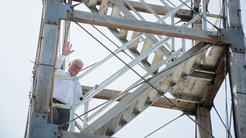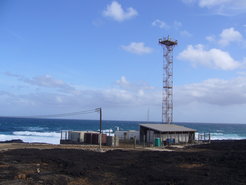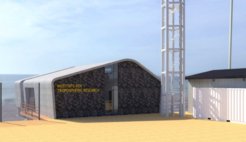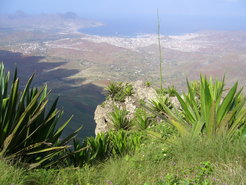Atmospheric research in the Atlantic to be expanded
The international Cape Verde Atmospheric Observatory (CVAO) is being further expanded: The President of the Republic of Cabo Verde José Maria Neves and German President Frank-Walter Steinmeier laid the foundation for a new laboratory building on São Vicente, one of the Cape Verde Islands off Africa, on Thursday. The island in the tropical Atlantic has become an international focal point of climate research in recent years. The atmospheric observatory has therefore now become part of the European research infrastructure ACTRIS. It is jointly operated by a consortium of the Cape Verde Institute for Meteorology and Geophysics (INMG), the Leibniz Institute for Tropospheric Research (TROPOS) in Leipzig, the Max Planck Institute for Biogeochemistry in Jena (MPI-BGC) and the University of York in the UK. The investments in new rooms and technology are being funded by the Federal Ministry of Education and Research with over 3 million euros as part of Germany's ACTRIS-D contribution. Germany is thus greatly intensifying its research cooperation with the Republic of Cabo Verde and providing important data from a key region of global climate change.
President Steinmeier had afterwards visited the Ocean Science Centre Mindelo (OSCM), which is operated by the German GEOMAR Helmholtz Centre for Ocean Research Kiel together with the Cape Verdean Instituto do Mar, and inaugurated a TROPOS measuring station for remote sensing of the atmosphere there. Steinmeier's visit is the first state visit by a German President to the Republic of Cabo Verde, which consists of ten islands in the Atlantic Ocean and has around half a million inhabitants. Climate change and the research of the Helmholtz Association, the Leibniz Association, the Max Planck Society and various universities on the subject are a focus of the three-day trip.

"Cabo Verde is 'on the frontline of the climate crisis' ", as UN Secretary-General Guterres put it earlier this year during his visit on the occasion of the Ocean Race Summit. "The island states are vulnerable in different ways, but they are united in their vulnerability. The people here in Cabo Verde are therefore not fighting alone on the frontline of the climate crisis, but are looking for allies. Not suffering, but tackling: That is the attitude with which we must face this human task, and your example can encourage us all!" said German President Frank-Walter Steinmeier to Cabo Verde's National Assembly before meeting scientists from Cabo Verde and Germany who are researching how climate change is altering the ocean and the atmosphere. Cabo Verde's location in the tropical Atlantic makes it particularly interesting for international atmospheric and climate research: the islands lie in the zone of the northeast trade wind, which regularly transports Saharan dust from northwest Africa across the Atlantic to the Caribbean and South America. The Cape Verde Islands are located in the tropical Atlantic Ocean, about 800 kilometres from the western tip of the African continent and over 3000 kilometres from the nearest tropical ocean islands. The Republic of Cabo Verde, which has been independent since 1975, is now one of the most stable and prosperous countries in Africa.

In 2006, researchers from Germany and Great Britain founded the Cabo Verde Atmospheric Observatory (CVAO) together with local partners. Its location on a cliff near Calhau on the north-eastern tip of the island of São Vicente is a good reflection of the atmospheric situation on the Atlantic, as the air there usually comes from the ocean in the north-east and so local emissions play practically no role. At the centre of the measurements is a 30m high tower, which was built in 2010 with funding from the Leibniz Association under the leadership of TROPOS together with the Max Planck Institute for Biogeochemistry. Its height enables measurements of the atmosphere without being directly affected by the spray from the coastal surf. The tower was built from German oak because wood proved to be more durable than metal, which corrodes quickly due to the high salt content of the air.
The CVAO is part of a long-term measurement programme in the tropical North Atlantic and is one of the 32 most important atmospheric stations in the Global Atmosphere Watch (GAW) programme of the World Meteorological Organization (WMO). The Max Planck Institute for Biogeochemistry in Jena (MPI-BGC) measures greenhouse gases such as methane, carbon dioxide and nitrous oxide at the CVAO. The CVAO has a similar significance for international climate research as, for example, prominent stations on the Zugspitze in the Alps, Mauna Loa in Hawaii, Neumayer-III in Antarctica or the ATTO tower in the Amazon. In addition to these global networks, the Cabo Verde Atmospheric Observatory is now also part of the European network ACTRIS (Aerosol, Clouds and Trace Gases Research Infrastructure), the largest multi-site infrastructure for atmospheric research worldwide. A total of 11 universities, research institutes and authorities are involved in the German ACTRIS contribution (ACTRIS-D), which is coordinated by TROPOS. The construction of the German calibration centres, observation stations, atmospheric simulation chambers and mobile measurement platforms planned until 2029 is being funded by the Federal Ministry of Education and Research (BMBF) with a total of 86 million euros over a span of eight years. Of this, around 3 million euros will be invested in Calhau and Mindelo to significantly expand the CVAO.

"Until now, the equipment in Calhau was housed in containers. Now a permanent laboratory building will be added, as well as a photovoltaic system that will guarantee an uninterrupted, reliable power supply. The existing in-situ measurements of aerosols will be expanded and modernised: New equipment can measure the light scattering of particles, the chemical composition and the content of trace metals as well as cloud condensation nuclei in real time. In the future, the automation of aerosol and cloud water samples will ensure that the data is available much faster than before," explains Prof. Hartmut Herrmann from TROPOS, the scientific director of the CVAO and the Atmospheric Chemistry Department (ACD) of TROPOS. "The new laboratory building for the CVAO will significantly improve the investigation possibilities for dust and marine aerosol particles. The CVAO will thus be strengthened and attractive for guest users. Through the construction measures, we are supporting the local economy and, with its use, local academic education."

DThe in-situ measurements in Calhau are now complemented by measurements in Mindelo: On the roof of the Ocean Science Centre Mindelo (OSCM), a remote sensing station was built in cooperation with the German GEOMAR Helmholtz Centre for Ocean Research Kiel and the Cape Verdean Instituto do Mar, which investigates particles in the atmosphere up to a height of 30 kilometres. For this purpose, a lidar device developed by TROPOS was installed in 2021, whose laser has already made an important contribution to the validation of the ESA wind satellite Aeolus. The lidar was supplemented in 2023 by instruments for remote cloud sensing: a microwave radiometer, a wind lidar and a cloud radar. Likewise, instruments for measuring solar and thermal radiative fluxes were installed to determine the influence of aerosols and clouds on the radiative forcing of the atmosphere and ocean. With these additions, this ACTRIS station is now complete and officially began operations for the visit of the German President on 5 October 2023. "The station will also serve as a reference station for the Earth observation satellite EarthCARE, which the European ESA and the Japanese JAXA plan to launch in 2024 to study aerosols and clouds and their influence on radiation in the Earth's atmosphere. The expansion of the Cabo Verde Atmospheric Observatory follows the strategic goals of TROPOS to record and ultimately understand the complex processes of the atmosphere on a long time-scale. Cooperation with GEOMAR's ocean research will play an important role in this," explains Prof. Andreas Macke, Director of TROPOS and Head of the Remote Sensing Department.

São Vicente, with the Ocean Science Centre Mindelo (OSCM) and the Cabo Verde Atmospheric Observatory (CVAO), is a prime example of international cooperation in atmospheric and climate research: here, marine and atmospheric research work hand in hand, as well as three non-university research communities - Helmholtz, Leibniz and Max Planck. The researchers come to Cabo Verde from a wide variety of countries - above all from Germany and Great Britain, but also from the USA and China.
This cooperation benefits not only international climate research and the entire global community through improved climate forecasts, but also the local population: In the DUSTRISK project, researchers from various Leibniz institutes are working together with institutions from Cabo Verde to investigate the effects of desert dust on health. The aim is to establish a warning system that can help to better protect the population. Together with TROPOS, the environmental authority Direção Nacional do Ambiente (DNA) and the weather service Instituto Nacional de Meteorologia e Geofísica (INMG) want to set up a network to monitor air quality.
This press release was kindly provided by TROPOS/Tilo Arnhold.
















